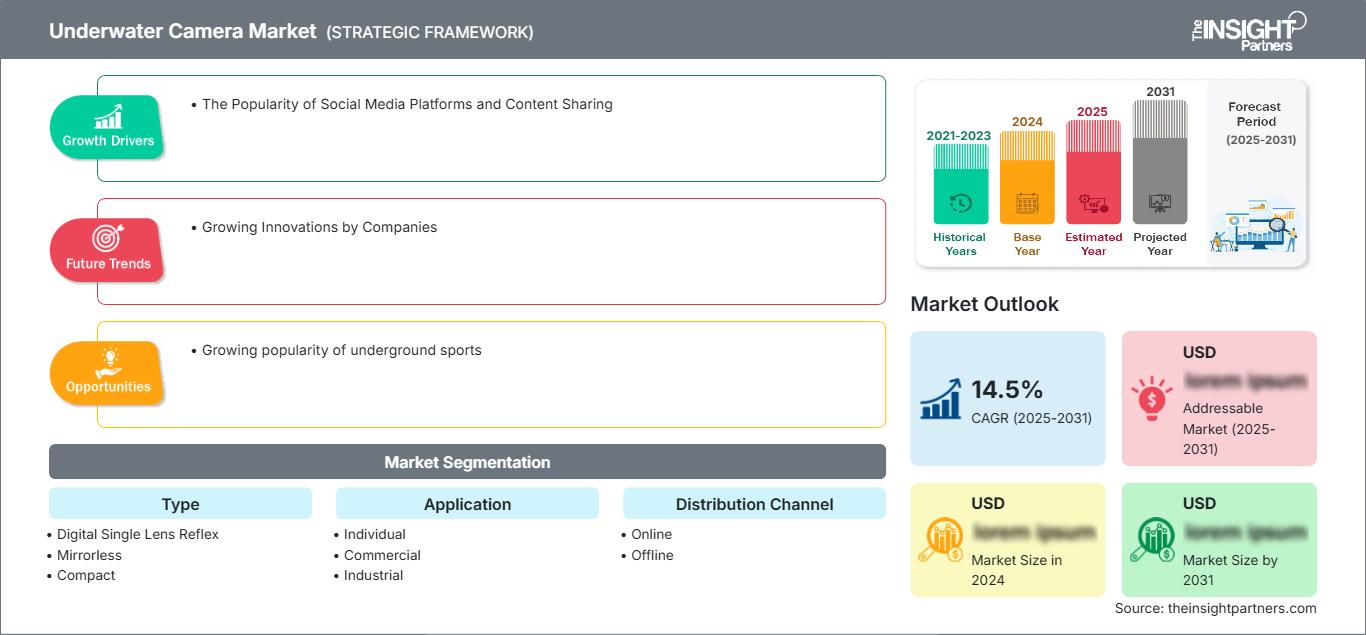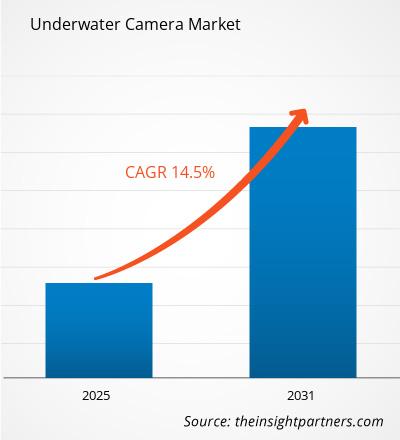页面已更新 :
Sep 2024
预计到 2031 年,水下相机市场规模将从 2023 年的 86.4 亿美元增至 255.4 亿美元。预计该市场在 2023 年至 2031 年期间的复合年增长率为 14.5%。地下运动的日益普及很可能仍将是市场的主要趋势。
水下相机市场分析
- 旅行和商业摄影中的水下相机是两个重要的市场驱动力。坚固耐用且防水的相机能够在各种天气条件下进行拍摄,这对水下相机市场产生了重大影响。人们对摄影和摄像作为一种业余爱好的兴趣日益浓厚,也是一个重要的市场驱动力。
- 随着全球旅游业重新开放,人们开始前往水下探索独特的地方。水下相机在纪录片行业和水下旅游方面具有巨大的潜力。防水相机市场可以从海洋生物产业的水下相机应用受益。
- 这一增长归功于尼康、佳能等防水相机制造企业。水下摄影在青少年中日益增长的知名度推动了该地区市场的发展。
水下相机市场概览
- 水下相机是一种用于在水面下捕捉图像和视频的专用设备。它适用于各种场景,包括游泳、浮潜或通过遥控水下机器人进行摄影。
- 一些水下相机甚至具备自动化功能,可以毫不费力地从水面潜入水中,自主记录视觉内容。虽然某些相机专为水下应用而设计,包括现代防水数码相机,但其他专为干燥条件设计的相机可以在水下使用,并配备额外的保护外壳以防水防压。
自定义此报告以满足您的要求
您将免费获得任何报告的定制,包括本报告的部分内容,或国家级分析、Excel 数据包,以及为初创企业和大学提供超值优惠和折扣
水下相机市场: 战略洞察

- 获取本报告的主要市场趋势。这个免费样本将包括数据分析,从市场趋势到估计和预测。
水下相机市场驱动力与机遇 社交媒体平台和内容分享的普及
自定义此报告以满足您的要求
您将免费获得任何报告的定制,包括本报告的部分内容,或国家级分析、Excel 数据包,以及为初创企业和大学提供超值优惠和折扣
水下相机市场: 战略洞察

- 获取本报告的主要市场趋势。这个免费样本将包括数据分析,从市场趋势到估计和预测。
- 社交媒体平台的蓬勃发展以及与家人、粉丝和朋友分享独特体验的愿望,极大地影响了水下相机的需求。社交媒体平台已成为每个人生活中不可或缺的一部分,是人们联系和自我表达的平台。专注于冒险、旅行和户外活动的网红经常将水下内容融入到他们的动态中,为粉丝带来身临其境的体验。网红的推荐和水下相机的使用极大地影响了受众的购买决策,从而为水下相机市场带来了良机。
- 此外,水下相机可以拍摄水下运动和活动的照片和视频。普通相机不适合水下摄影和视频,因为它们的集成电路防护有限,并且不适用于水或雪等极端条件。水下相机结构紧凑、重量轻,专为恶劣条件而设计,可在工业环境中高效工作。它们可以在水下佩戴。这些相机用于在水下拍摄高速高质量的图像。因此,有影响力的网红会利用水下相机拍摄的照片来增加粉丝。社交媒体平台和内容分享的日益普及,也推动了全球市场对水下相机的需求。
公司不断创新
- 各公司不断投资研发,从而提升了图像质量、增强了耐用性,并增加了水下模式和自动校正等特殊功能。
- 多家公司正在推出各种类型的水下相机。例如,2024 年 7 月,总部位于哈利法克斯的水产养殖业人工智能制造商 ReelData 推出了其首款实体产品:一款旨在与水产养殖运营商的计算机系统集成的水下相机。该相机的带宽和压缩能力经过定制,可与 AI 系统完美配合,而且设备本身防水且足够坚固,可在各种恶劣环境下使用。
- 市场参与者的此类创新为预测期内水下相机市场的增长创造了机会。
水下相机市场报告细分分析
促成水下相机市场分析的关键细分是类型、应用和分销渠道。
- 根据类型,水下相机市场分为数码单反相机 (DSLR)、无反光镜相机和紧凑型相机。
- 根据应用,市场分为个人、商业和工业。
- 根据分销渠道,市场分为线上和线下。
按地区划分的水下相机市场份额分析
- 水下相机市场报告对五个主要地理区域进行了详细分析,包括当前和历史市场规模和2021年至2031年的预测,涵盖北美、欧洲、亚太地区 (APAC)、中东和非洲 (MEA) 以及南美洲和中美洲。
- 每个地区进一步细分为相应的国家/地区。本报告提供对18个以上国家/地区的分析和预测,涵盖水下相机市场动态,例如影响区域市场的驱动因素、趋势和机遇。
- 此外,本报告还涵盖PEST分析,其中涉及研究影响这些地区水下相机市场的主要因素。
水下相机市场
The Insight Partners 的分析师已详尽阐述了预测期内影响水下相机市场的区域趋势和因素。本节还探讨了北美、欧洲、亚太地区、中东和非洲以及南美和中美洲的水下相机市场细分和地域分布。
水下相机市场报告范围
| 报告属性 | 细节 |
|---|---|
| 市场规模 2024 | US$ XX million |
| 市场规模 2031 | US$ XX Billion |
| 全球复合年增长率 (2025 - 2031) | 14.5% |
| 历史数据 | 2021-2023 |
| 预测期 | 2025-2031 |
| 涵盖的领域 |
By 类型
|
| 覆盖地区和国家 | 北美
|
| 市场领导者和主要公司简介 |
|
水下相机市场参与者密度:了解其对业务动态的影响
水下相机市场正在快速增长,这得益于终端用户需求的不断增长,而这些需求的驱动因素包括消费者偏好的不断变化、技术进步以及对产品优势的认知度不断提高。随着需求的增长,各企业正在扩展产品线,不断创新以满足消费者需求,并抓住新兴趋势,从而进一步推动市场增长。

- 获取 水下相机市场 主要参与者概述
水下相机市场新闻及最新动态
对水下相机市场的评估是通过收集一手和二手研究后的定性和定量数据进行的,这些数据包括重要的公司出版物、协会数据和数据库。
- Ace Aquatec 推出了另一款创新产品 A-BIOMASS - 一种自动化 AI 摄像系统,它将彻底改变全球养鱼户的生物量数据捕获方式。A-BIOMASS 是一种先进的水下摄像系统,它承诺通过使用机器学习和人工智能 (AI) 实现实时毫米级精度,从而改变全球养鱼户监测和分级鱼类资源的方式。(来源:Ace Aquatec,公司网站,2023 年 8 月)
- 富士胶片推出了 QuickSnap。这款防水相机是一次性使用的相机,可在水下 35 英尺(约 10 米)深的地方使用,其特点包括 27 次 ISO 800 胶片曝光、彩色照片以及 32mm f/10 定焦镜头。(来源:富士胶片,简报,2021 年 3 月)。
水下相机市场报告内容和交付成果
《水下相机市场规模及预测(2021-2031)》报告提供了涵盖以下领域的市场详细分析:
- 水下相机市场规模以及涵盖范围内所有关键细分市场的全球、区域和国家/地区预测。
- 水下相机市场趋势以及市场动态,例如驱动因素、限制因素和关键机遇。
- 详细的 PEST/Porter 五力模型和 SWOT 分析。
- 水下相机市场分析涵盖关键市场趋势、全球和区域框架、主要参与者、法规和最新市场发展。
- 行业格局和竞争分析涵盖市场集中度、热图分析、知名参与者和水下相机市场的最新发展。
- 详细的公司简介。
- 历史分析(2 年)、基准年、预测(7 年)及复合年增长率
- PEST和SWOT分析
- 市场规模、价值/数量 - 全球、区域、国家
- 行业和竞争格局
- Excel 数据集
近期报告
相关报告
客户评价
购买理由
- 明智的决策
- 了解市场动态
- 竞争分析
- 客户洞察
- 市场预测
- 风险规避
- 战略规划
- 投资论证
- 识别新兴市场
- 优化营销策略
- 提升运营效率
- 顺应监管趋势
我们的客户































87-673-9708

ISO 9001:2015



 获取免费样品 - 水下相机市场
获取免费样品 - 水下相机市场